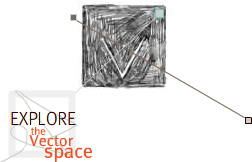WiFi.Bedouin
This is not the web without wires..
Design by Erik Loyer
Designer's Statement
Let's say you're drawing a networking diagram. How would you draw a wired connection between two computers? Probably with a line. You'd draw the line, and you'd understand that it meant information could flow both ways between the two machines.
How would you draw a radio broadcast? Concentric circles or arcs, perhaps? We've seen it a thousand times, and we know that information only travels one way across those curves.
Now, how would you draw a call between wireless phones? You might have to stop and think for a second first. In keeping with the above-mentioned wireless tradition, you might find yourself using concentric circles again, drawing a satellite orbiting the earth as the source of a broadcast enveloping both handsets. But those ripples generally mean one-way communication only, and so they don't seem fully adequate to account for the interactive conversation taking place between the two mobile phone users. So, what else do we draw?
We run into the same conundrum when attempting to represent wireless internet access. It's easy to diagram the broadcast area of a wireless hotspot with some concentric rings, but what about the activity taking place within that hotspot? What do we draw?
Julian Bleecker's WiFi.Bedouin complicates the issue further, by introducing the idea of a mobile WiFi hotspot that can, among other things, intercept and redirect the traffic of web surfers attempting to reach canonical websites. Intrigued by the way in which Julian's approach troubled our normal conceptions of wireless networks, I quickly became interested in the notion that we simply have not yet developed a popular visual vocabulary to adequately describe wireless connectivity—at least not in a way that would shed any light on people's behavior while using these networks. Working out such a vocabulary thus became the major focus of my work on this project, which is humbly offered as a step along the way.
It seemed important from the beginning to visualize wireless connectivity as a space where specific events could occur. WiFi access points thus became sources of this interactive space, and in my early sketches this was represented with cones of light, as if the wireless hotspot functioned like an overhead lamp whose illumination made useful activity possible in a darkened room. While this was a compelling metaphor, in the final analysis it carried too much physical baggage to be of much use. What proved more fruitful was inverting the cones of light, using them instead to carve out "airspace" above a physical location where network activity could take place. This is what you see in the final design.
There's significant terrain still to be explored in how we represent wireless connectivity visually, and thus how we describe to ourselves the methods we use to communicate and share information. One aspect that I noticed while putting this project together is how seeing the generic figures connecting to specific URLs immediately starts the narrative wheels turning in one's mind, speculating as to what this or that particular person is doing at this or that site. I found this to be a very visceral demonstration of just how much web addresses function for us as verbs, even as Julian's theoretical and technological innovations challenge us to reevaluate the potential meanings of those verbs.
-- Erik Loyer



